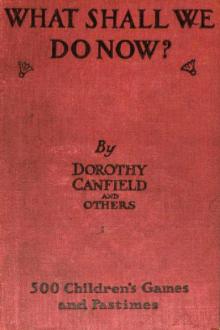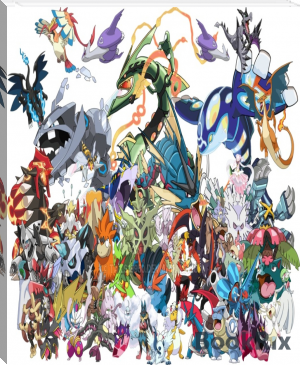What Shall We Do Now?, Dorothy Canfield Fisher [ebook offline reader .txt] 📗

- Author: Dorothy Canfield Fisher
- Performer: -
Book online «What Shall We Do Now?, Dorothy Canfield Fisher [ebook offline reader .txt] 📗». Author Dorothy Canfield Fisher
Pictures can also be pricked with a pin, but in this case some one must draw it first. You follow the outline with little pin pricks close together, holding the paper on a cushion while you prick it. Then the picture is held up to the window for the light to shine through the holes.
Easter EggsHome-made Easter eggs are made by painting pictures or messages on eggs that have been hard-boiled, or by merely boiling them in water containing cochineal or some other coloring material. In Germany it is the custom for Easter eggs to be hidden about in the house and garden, and for the family to hunt for them before breakfast—a plan that might very well be taken up by us.
Spatter-WorkPaper and cardboard articles can be prettily decorated by spatter-work. Ferns are the favorite shapes to use. You first pin them on whatever it is that is to be ornamented in this way, arranging them as prettily as possible. Then rub some Indian ink in water on a saucer until it is quite thick. Dip an old tooth-brush lightly into the ink, and, holding it over the cardboard, rub the bristles gently across a fine tooth comb. This will send a spray of ink over the cardboard. Do this again and again until the tone is deep enough, and try also to graduate it. It must be remembered that the ink when dry is much darker than when wet. Then remove the ferns, when under each there will be a white space exactly reproducing their beautiful shape. If you like you can paint in their veins and shade them; but this is not really necessary. Colored paints can be used instead of Indian ink.
ScrapbooksMaking scrapbooks is always a pleasant and useful employment, whether for yourself or for children in hospitals or districts, and there was never so good an opportunity as now of getting interesting pictures. These you select from odd numbers of magazines, Christmas numbers, illustrated papers, and advertisements. Scraps are very useful to fill up odd corners. In choosing pictures for your own scrapbook it is better to select only those that you really believe in and can find a reason for using, than to take everything that seems likely to fit. By choosing the pictures with this care you make the work more interesting and the book peculiarly your own. But in making a scrapbook as a present for some one that you know, you will, of course, in choosing pictures, try to put yourself in his place and choose as you think that he would.
Empty scrapbooks can be bought; or you can make one by taking (for a large one) an old business ledger, which some one whom you know is certain to be able to give you, or (for a small one) an ordinary old exercise-book, and then cutting out every other page about half an inch from the stitching. This is to allow room for the extra thickness which the pictures will give to the book. Or you can sew sheets of brown paper together.
For sticking on the pictures, use paste rather than gum; and when it is done, press the book under quite a light weight, with sheets of paper between the pages.
Scrapbooks for HospitalsChildren that are ill are often too weak to hold up a large book and turn over the leaves. There are two ways of saving them this exertion and yet giving them pleasure from pictures. One is to get several large sheets of cardboard and cover them with pictures and scraps on both sides, and bind them round with ribbon. These can be enclosed in a box and sent to the matron. She will distribute the cards among the children, and when they have looked at each thoroughly they can exchange it for another. Another way is to use folding books which are more easy to hold than ordinary turning-over ones, and you can make them at home very simply by covering half a dozen or more cards of the same size (post-cards make capital little books) with red linen, and then sewing them edge to edge so as to get them all in a row. In covering the cards with the linen—red is not compulsory, but it is a good color to choose—it is better to paste it on as well as to sew it round the three edges (a fold will come on one side), because then when you stick on the pictures they will not cockle up. Pictures for hospital scrapbooks should be bright and gay. Colored ones are best, but if you cannot get them already colored you can paint them. Painting a scrapbook is one of the best of employments.
Composite ScrapbooksSometimes it happens that you get very tired of one of the pictures in your scrapbook. A good way to make it fresh and interesting again is to introduce new people or things. You will easily find among your store of loose pictures a horse and cart, or a dog, or a man, or a giraffe, which, when cut out, will fit in amusingly somewhere in the old picture. If you like, a whole book can be altered reasonably in this way, or made ridiculous throughout.
Scrap-Covered ScreensA screen is an even more interesting thing to make than a scrapbook. The first thing to get is the framework of the screen, which will either be an old one the covering of which needs renewing, or a new one made by the carpenter. The next thing is to cover it with canvas, which you must stretch on tightly and fasten with small tacks; and over this should be pasted another covering of stout paper, of whatever color you want for a background to the pictures. Paste mixed with size should be used in sticking it. After the pictures are all arranged they should be stuck with the same material, and a coat of paper varnish given to the whole, so that it can be cleaned occasionally.
Collecting StampsStamp-collecting is more interesting if money is kept out of it and you get your stamps by gift or exchange. The best way to begin is to know some one who has plenty of foreign correspondence and to ask for all his old envelopes. Nothing but time and patience can make a good collection. To buy it, is to have little of the collector's joy.
Postage-Stamp SnakesOld American stamps can be used for making snakes. There is no need to soak the stamps off the envelope paper: they must merely be cut out cleanly and threaded together. A big snake takes about 4,000 stamps. The head is made of black velvet stuffed with cotton wool, and beads serve for eyes. A tongue of red flannel can be added.
PuzzlesIf you have a fret saw, and can use it cleverly, you can make at home as good a puzzle as any that can be bought. The first thing to do is to select a good colored picture, and then to procure from a carpenter a thin mahogany board of the same size. Mahogany is not absolutely necessary, but it must be some wood that is both soft and tough. Deal, for instance, is useless because it is not tough, and oak is useless because it is not soft. On this wood you stick the picture very firmly, using weak glue in preference to paste or gum. When it is quite dry you cut it up into the most difficult fragments that you can. It is best to cut out the border so that each piece locks into the next. This will then be put together first by the player and will serve to hold the picture together. After the puzzle is cut up it is well to varnish each piece with paper varnish, which keeps it clean and preserves it.
A simple puzzle can be made by pasting the picture on cardboard and cutting it up with scissors or a sharp knife.
Soap BubblesFor blowing bubbles the long clay pipes are best. Before using them, the end of the mouthpiece ought to be covered with sealing-wax for about an inch, or it may tear your lips. Common yellow soap is better than scented soap, and rainwater than ordinary water. A little glycerine added to the soap-suds helps to make the bubbles more lasting. On a still summer day, bubble-blowing out-of-doors is a fascinating and very pretty occupation.
Shadows on the WallShadowgraphy nowadays has progressed a long way from the rabbit on the wall; but in the house, ambition in this accomplishment does not often extend further than that and one or two other animals, and this is why only the rabbit, dog, and swan are given here. The swan can be made more interesting by moving the arm which forms his neck as if he were prinking and pluming, an effect which is much heightened by ruffling up and smoothing down the hair with the fingers forming his beak. To get a clear shadow it is necessary to have only one light, and that fairly close to the hands.
Leaves which are to be skeletonized should be picked from the trees at the end of June. They should be perfect ones of full growth. It is best to have several of each kind, as some are sure to be failures. Put the leaves in a big earthenware dish or pan, fill it with rain-water, and stand it in a warm and sunny place—the purpose of this being to soak off the green pulpy part. There is a great difference in the time which this takes: some fine leaves will be ready in a week, while others may need several months. Look at the leaves every day, and when one seems to be ready slip a piece of cardboard under it and shake it about gently in fresh cold water. If any green stuff remains, dab it with a soft brush and then put it into another basin of clean water. A fine needle can be used to take away any small and obstinate pieces of green. It is now a skeleton and must be bleached according to the following directions:—Pour into a large earthenware jar a pint of water on half a pound of chloride of lime. Mix thoroughly, breaking up any lumps with the hand. Add two and a half quarts of water, cover over, and leave for twenty-four hours. Then pour off the solution, leaving the sediment behind. Dissolve two pounds of soda in one quart of boiling water, and pour it, while on the boil, over the chloride solution. Cover it, and leave for forty-eight hours; then decant into bottles, being careful to leave all sediment behind.
Fill an earthenware dish with this solution, lay the leaves in it, and cover tightly. The leaves will be bleached in six to twelve hours. They should be taken out directly they are white, as the lime makes them very brittle. After bleaching, rinse the leaves in cold water, float them on to cards, and dry between blotting-paper, under a heavy weight.
FernsIt should be noted that if you intend to skeletonize ferns, they should not be picked before August, and they must be pressed and dried before they are put into the bleaching solution, in which they ought to stay for three or four days. The solution should be changed on the second day, and again on the fourth. After bleaching they can be treated just as the leaves are.
Wool BallsCut out two rings of cardboard, of whatever size you like, from one inch in diameter up to about four





Comments (0)